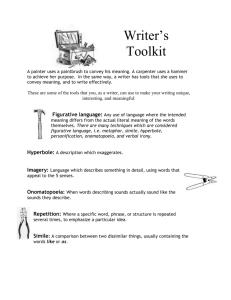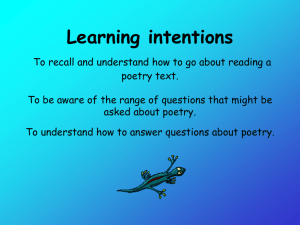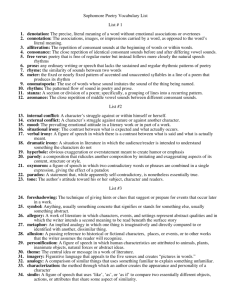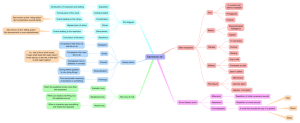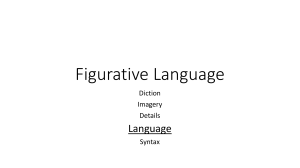literary_terms
advertisement
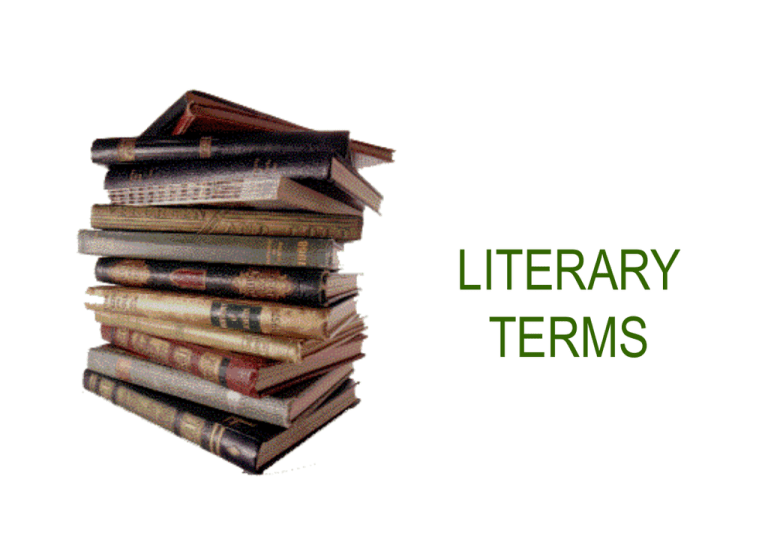
LITERARY TERMS alliteration • the repetition of initial consonant sounds, helps to form the pattern of poetry. Although it can sound comical or forced when used to excess (like in tongue-twisters), alliteration used deftly can create memorable and moving lines. The day of his death was a dark cold day. assonance • the repetition of vowel sounds when consonant sounds are unlike, creating partial rhyme such as late/make. • "Time out of mind", "slap dash", and "free and easy" all have assonance, or internal rhyme. A sadder and a wiser man He rose the morrow morn. consonance • the repetition of consonant sounds when vowel sounds are unlike. "First and last", "hill and dale", "stroke of luck“ • In each of these pairs the words begin differently and have unlike vowel sounds, yet each pair "clicks" because of repeated consonant sounds. "A lonely cab-horse steams and stamps." onomatopoeia • words that sound like what they mean. • Listen to summer; the "whirring of bees; the "slap and slop" of waves against a boat; the "plinkle" of ice in a glass. • Words like "bang", "boom" and "sizzle" are simple onomatopoeia. "I heard a fly buzz when I died -" allusion • A brief, undeveloped reference to a presumably familiar place, event, or figure from history, literature, mythology, or the Bible. • The magic of allusion is its shorthand. A single word of phrase can trigger a host of associations. • She has the mouth of Eminem, but the body of Shania. From this allusion, one can assume the woman in question is beautiful, but given to rude and vulgar speech. hyperbole • overstatement, an exaggeration used for humour or emphasis. • “It’s raining cats and dogs.” imagery • the use of vivid language to convey sensations and it helps us to experience fully what we read. We experience much of life through our senses, the flicker of a candle, the smell of wood smoke on a winter night, the taste of raspberries warm from the sun.... Look for imagery in these lines from "Winter" by William Shakespeare. When icicles hang by the wall And birds sit brooding in the snow, And Marion's nose looks red and raw When roasted crabs hiss in the bowl, Then nightly sings the staring owl, "Tu-whit, tu-who!" irony • verbal irony - implies the opposite of what is said • dramatic irony – occurs when the audience is aware of something that a character or characters are not • situational irony – occurs when the unexpected happens personification • the giving of human characteristics to an animal, object, or idea. • The writer using personification depends upon that knowledge of people and human behaviour held in common by most readers, as shown by 19th-century English novelist Charles Dickens, when he personifies fog as "cruelly pinching the toes and fingers" of a young deck hand. More recently, the late U.S. Senator Adlai Stevenson used personification in describing Eleanor Roosevelt: "Falseness withered in her presence, hypocrisy left the room." metaphor • an implied comparison between two unlike things. While a simile states that is something is a comparison, a metaphor substitutes a new idea for the original and is often direct and strong, as when Robinson Jeffers, modern American poet, says the Pacific is "a bulging eyeball of water". "An aged man is but a paltry thing, A tattered coat upon a stick." simile • an obvious comparison between two unlike things. It is easy to spot because it is always prefaced by "like", "as", "similar to", "resembles" or "as if". • A writer who uses simile helps readers to understand something new by comparing it with something familiar, as does the contemporary American poet W.D. Snodgrass in his simile of a milkweed pod: "Bulging like a coin purse fallen on the ground of damp woods.“ • “Life is like a game.” symbol • an object that stands for something larger that itself, usually an abstract concept. It means both what it is and something more, as a dove is both a bird and a symbol of peace. • William Blake, the 18th-century English writer and artist, often used symbols in his poetry. In "A Poison Tree", the growth of hatred is symbolized as a young sapling being nurtured into a tree. In the two poems "The Lamb" and "The Tiger", Blake symbolizes the gentle and the mighty sides of God. • "The Road Not Taken", by the modern New England poet Robert Frost, is about coming to a fork in the road and having to decide which road to take. It symbolizes the choices we face in life. • The maple leaf is both the part of an actual tree and a powerful symbol of Canada. plot – antecedent action – initial incident – rising action – climax – falling action – resolution conflict • man vs man • man vs self • man vs nature character • • • • • round/flat static/dynamic major/minor antagonist/protagonist stereotype setting • time • place theme • a general truth about life point of view • • • • first person limited omniscient omniscient objective tone and mood • tone – how the author feels • mood – the atmosphere created
